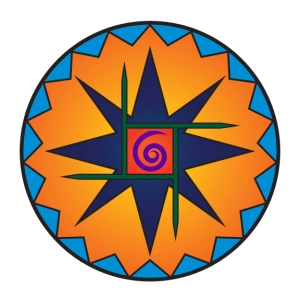The four Fire Festivals mark the major points of the ritual year for Clann Bhríde. We set aside time in our private lives to observe the presence of Brighid in the changing seasons while celebrating the arrival of each festival with friends and family. Because we have members all over the globe, we as a group celebrate both Northern and Southern hemisphere festivals at the same time. Individuals are welcome to adapt our ritual calendar as best suits their local geography and climate. While we do offer specific dates for each festival, it is important to view them as opportunities to mark periods of inner and outer transformation. As such, the window for celebrating each Fire Festival is quite large and may be observed at the individual’s discretion.
Brighid and the Themes of the Festivals
Our ritual year begins at Imbolc. Each Fire Festival is linked to Brighid’s myths and lore in some way and may be observed with reading and meditating on these sacred stories. Festival celebrations are traditionally held on the evening before the actual date, following the ancient Celtic tradition of days being marked from sundown to sundown.
Imbolc
Northern Hemisphere Date: February 1st
Southern Hemisphere Date: August 1st
Theme: Brighid and Her cow visiting the homes of the world, the infant Brighid or Brideog.
Beltane
Northern Hemisphere Date: May 1st
Southern Hemisphere Date: November 1st
Theme: Brighid and Aengus, or Brighid as the Shepherdess.
Lunasa
Northern Hemisphere Date: August 1st
Southern Hemisphere Date: February 1st
Theme: Brighid as the Harvest Maiden.
Samhain
Northern Hemisphere Date: November 1st
Southern Hemisphere Date: May 1st
Theme: the Cailleach, or Brighid as the mournful mother.
Ritual Outline
- Spend the day doing appropriate activities until sunset.
- Bless water with fire, circumambulate the ritual space and sain the four quarters and all participants.
- Read or sing prayers.
- Hold a feast, with one table setting for Brighid. Also leave some of the food aside for an offering to Brighid, to the Sidhe, and to any other appropriate powers.
- Read or tell traditional tales.
- Leave the food offering outside or on the altar. Libations such as milk can also be poured on the ground or the threshold.
- Celebrate with music and dancing.
Other Holy Days
While Clann Bhríde only officially celebrates the four Fire Festivals, we do recognize other points in the year as opportunities for celebrating Brighid’s presence in the world. These dates may be particularly appropriate for individuals who follow the Wheel of the Year, a relatively recent concept which includes the four Fire Festivals as well as the two solstices and equinoxes.
Latha na Caillich
This minor Scottish Gaelic holiday is supposed to represent the final victory of Bride and Aengus (representing the spring) over the Cailleach (representing the winter), or the day on which the Cailleach bathes in the Well of Youth and transforms into Bride for the summer. The day was originally not fixed, because it referred to whichever day happened to be the last day of wintery weather before true spring began. Over time it became fixed as March 25, which happens to be near the spring equinox. You can celebrate this day as a spring equinox holiday, or you can celebrate it in conjunction with Easter or St. Patrick’s day as a simple springtime party. This would also be a good day for well-tending or river-tending.
Midsummer
Traditionally the festival of Aine of Munster, a goddess associated with healing herbs, poetic inspiration and sexuality, fell on St. John’s Day or June 24. This is near the summer solstice but not directly associated with it. If you want to celebrate midsummer, it would be a good day to honor Brighid as the Three Sisters: Brighid the Poetess (whose sunbeams strike the plants along the Boyne river once every seven years on this date, creating the Imbas), Brighid the healer (since healing herbs gathered on this date were said to be at their most powerful), and Brighid the Smith (since forge fires are reminiscent of the bonfires held on this day).
Cailleach an Dudain
The Scottish Gaelic festival of Michaelmas on September 29 (near but not on the autumn equinox) was associated with carrots as symbols of fertility and courtship. Women would pick wild carrots and young women would make gifts of them to young men they hoped would court them. A dance-play was performed on this day in which a man with a druidic wand “killed” the Cailleach, mourned her, then revived her with his wand. This represents the Cailleach’s return with the end of summer. The last sheaf of the harvest was also called the Cailleach. It was traditionally considered acceptable to steal horses on this day. If you want to celebrate the autumn equinox time period, you could have a meal with carrots or stage a version of the Cailleach an Dudain dance.
Midwinter
Stay up all night with a burning candle in the shape of an old woman, representing the Cailleach (traditionally a “Cailleach log”).

